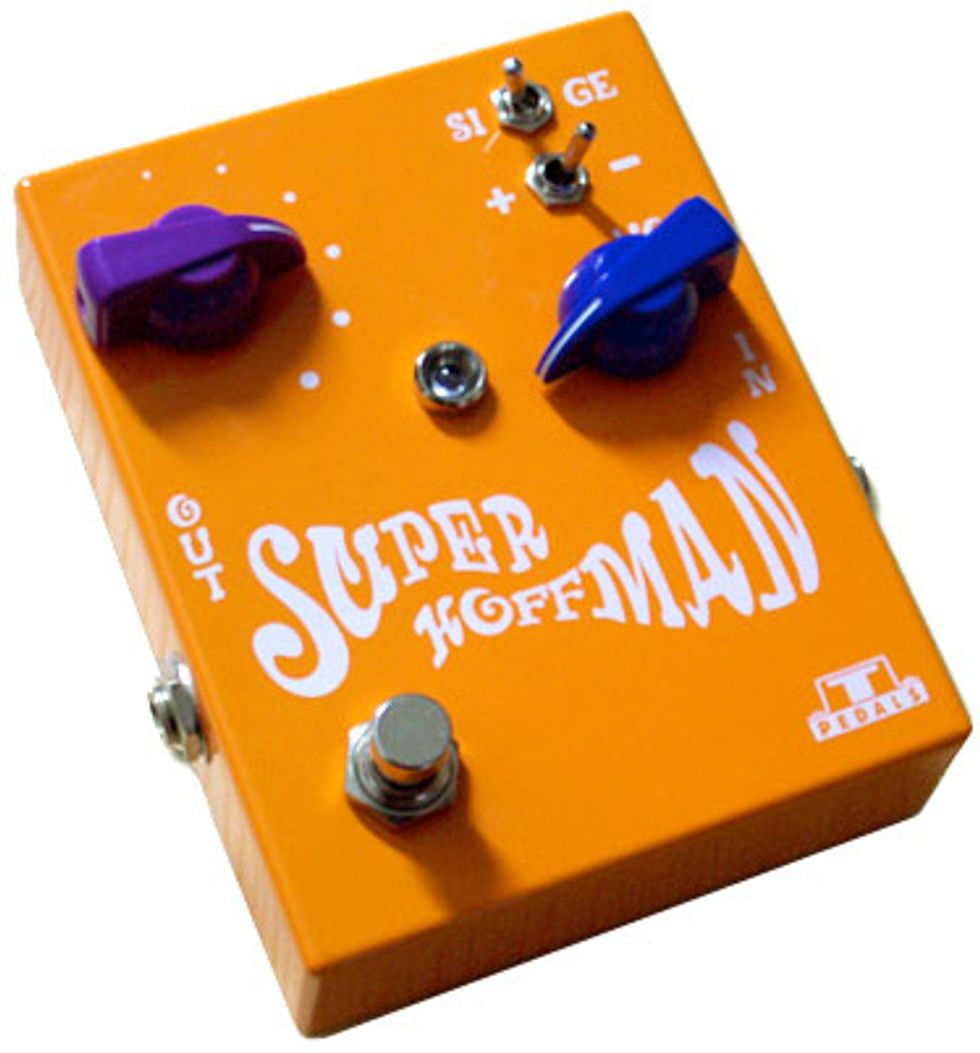 | |
| Download Example 1 Germanium diode selected, +/- switch set to +. Fender Twin Reverb Reissue. | |
| Download Example 2 Cycling through the six frequency stages, starting with the most treble boost. Marshall JCM800, slightly overdriven. | |
| Clips recorded with 2008 Fender American Stratocaster. | |
Right To The Point
The Super Hoffman’s internal circuitry is based in a time-honored, true point-to-point fashion. There is absolutely no circuit board housed inside of the enclosure, just an assemblage of capacitors, resistors, and diodes that are expertly soldered from one component joint to another. DIY’ers who have attempted PTP circuit design understand that it can be a real pain to craft a circuit that keeps each component lead from touching another. Thankfully, the Super Hoffman’s circuit layout resembles a fine work of art, rather than a rat’s nest of wires and solder.
A Modern Edge With A Vintage Flavor
Not only does the Super Hoffman share a circuit build similar to vintage fuzz effects, it also features a set of tone shaping options that harkens to the era of fuzz boxes from the ‘60s and ‘70s. At the heart of the effect is a six-way rotary switch that changes the peak frequencies—and amount of gain—of the overall tone. The frequencies range from thin, reedy treble with a clean top end to a woolly fuzz with a large bass boost. The fuzz is generated by a single diode in the circuit, which is switchable between being either germanium or silicon-based. Finally, a switch labeled +/- switches between a smooth, high-gain tone and a cleaner, lower-gain fuzz with a more prominent quack in the midrange.
Muscular Tone
The Super Hoffman is a killer-sounding fuzz pedal on its own, with a sound that shares the horn-like qualities of the famed Maestro Fuzz Tone, but even more impressive is how well it acts as a treble and midrange booster—almost like a preamp, but in a fuzz pedal flavor. Plugging in with a 2008 Fender American Telecaster into a reissue Fender Twin Reverb combo, this benefit was immediately apparent. After I dialed in some grit from the Twin, I let the Super Hoffman do the rest of the work, adjusting the frequency knob to taste. As expected, the silicon diode mode tightened up the attack nicely, but I found myself laying back with the juicy feel of the germanium mode. The Super Hoffman is not a high-gain fuzz by any means, rather a nice add-on to an already overdriven amplifier that needs more cut and punch.
The Final Mojo
For players who understand just how well a good fuzz booster can open up a nice tube amp, the Super Hoffman is a great choice. It’s well built, versatile, and sounds fantastic. It definitely doesn’t have the massive gain as, say, an Electro-Harmonix Big Muff, but it has tonal clarity and a set of features that set it apart from a lot of other fuzzes on the market.
Buy if...
you’re after classic fuzz booster tone with more tonal range and features than the average vintage fuzz box.
Skip if...
you need a high-gain fuzz.
Rating...
Street $309.99 - T-Pedals - g-spot-music.com |
| Tone Games 2010, Bonus Levels: 10 More Stompboxes Reviewed | Next up: T-Rex Octavius Tri-Tone Generator |















![Rig Rundown: AFI [2025]](https://www.premierguitar.com/media-library/youtube.jpg?id=62064741&width=1245&height=700&quality=70&coordinates=0%2C0%2C0%2C0)












 Shop Scott's Rig
Shop Scott's Rig